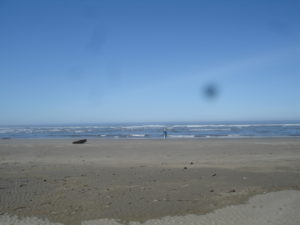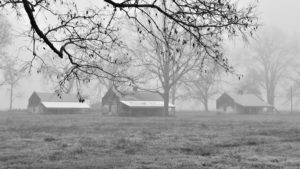We have a number of friends and family members that are interested in photography so we thought we might create a page to describe the evolution of our photography and the equipment we are using as we travel.
When first we hit the road, Gail was using her Samsung S7 phone to document our travels while Bruce was using the Sony Cybershot DSC-P200 compact camera that we had been using for almost 20 years. The phone takes surprisingly good photos and the Sony does quite well too but they each have limitations.
As those of you that rely on your phone camera to take pictures already know, it can sometimes be quite difficult to see the screen, so composing the shot can be challenging. With compact cameras such as the Cybershot, they tend to pump dirt and dust into their insides every time they are turned on and off. After a while, spots and smudges will start to appear in pictures as the sensor gets dirty. As you can clearly see in this photo, this happened soon after we started our adventures.
The only fix is take the camera apart and clean the sensor, which is what Bruce did soon after this picture was taken. We were using the camera a lot and quite often in dusty, dirty conditions, so it didn’t take long for new spots to appear on our pictures. The decision was made to buy another inexpensive camera just before we went the see the Spruce Goose in Oregon. Now we had two compact cameras that we could use in rotation and clean as necessary. The hope was that we would always have a usable camera.
Compact cameras are really nice since they can easily slip into the pocket. Given the dirt issue and the limitations of this type of camera, we started to consider upgrading to a DSLR. So many times Bruce emphatically stated that he didn’t want to spent his day lugging around a big camera and lenses.
All that started to change as we got more interested in birding. We needed a good camera and lenses to really enjoy that. So we ordered a kit with the Nikon D5600 camera. Included with this kit was a 18-55 mm, f/3.5-5.6 lens and a 70-300 mm, f/4-5.6 telephoto, among other incidental accessories. This really got us going on birding and wildlife photography and all seemed well until the day we set up our gear to photograph a herd of elk in Yellowstone National Park and a lady set up next to us using a 150-600 mm telephoto lens. Given the opportunity for a side by side comparison of our 300 mm lens to her 600 mm lens, we were suddenly in the market for a 600 mm lens.
So now we had added a Tamron 150-600 mm, f/5-6.3 lens to our camera bag. Then came a 1.4 teleconverter that, when used with the 600 mm lens, creates an effective focal length of 850 mm. Now we are able to get up close and personal with wildlife subjects.
The ability to use different lenses is what makes this type of camera so versatile. But changing lenses can be a bit challenging out in the field so when our cousin Tom introduced us to his new Nikon 18 mm to 300 mm telephoto lens we knew this lens would be very useful for the birding, wildlife and landscape photography that we enjoy. Thanks to Amazon, we had another new lens within a couple days.
There is one more piece of photographic equipment worth mentioning. We have a DJI Phantom 4 drone with a 4 K camera. This little guy has given us an aerial view of some incredible places.
On December 14 2019, Bruce attended a photography workshop at Magnolia Plantation near Natchitoches (pronounced Nack-a-dish) LA. The workshop was sponsored by the National Park Service and hosted by art teacher and professional photographer Annabel Jones. Bruce said that his main takeaway from the workshop is that he still has a great deal to learn about photography.
Three of the remaining slave quarters at Magnolia Plantation.
We are having having a really nice time discovering some of the amazing sights this country has to offer. We hope to share with you some of what we see through our photography. Enjoy.


